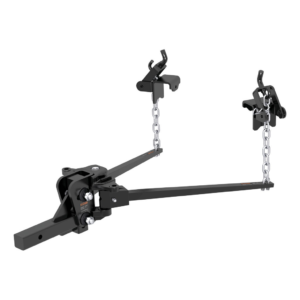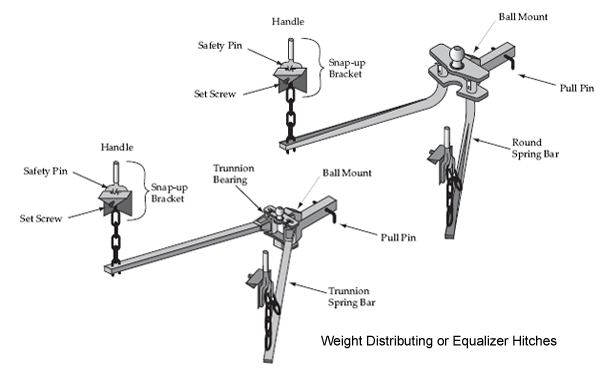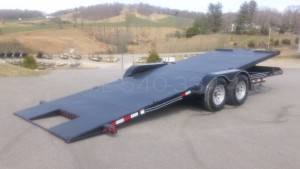Weight Distribution Trailer Hitch 101
TRAILER 101: WEIGHT DISTRIBUTION & TOWING
Weight Distribution Trailer Hitch
When hauling your trailer, proper weight distribution (WD) is critical for safe and smooth towing. Improper weight distribution is a key factor in those heart-pounding braking and steering moments on the road. It’s not only hard on your vehicle and trailer, but it can also have negative consequences on your safety and result in accidents.
Instead of the weight resting at the center of the hitch, a weight distribution hitch shifts the weight forward towards the rear of the vehicle and back at the front of the trailer for even distribution. This makes it easier on you, your tow vehicle, and your trailer to transport heavier loads.

Weight distribution involves gross trailer weight and trailer tongue weight.
- Gross trailer weight (GTW) – Total weight of a trailer (includes cargo)
- Tongue weight (TW) – Weight that bears down on the hitch (includes weight towards the front of the trailer, as well as weight behind the towing vehicle’s rear axle)
An imbalance of the proportion of GTW to TW can cause multiple problems. Too much TW (usually 10-15% of the gross trailer weight) compared to GTW causes the trailer hitch to sink down or dive. Not enough TW causes the trailer hitch to raise upwards. This difference in weight also increases the chances of trailer sway, where the trailer sways from left to right as it’s towed behind the vehicle.
Benefits of a Weight Distribution Hitch
A weight distribution hitch offers many benefits over a standard hitch, such as:
- Even weight distribution (Up-and-down motion)
- Eliminates risk of swaying (Side-to-side motion)
- Increases trailer tow capacity
- Better control over your vehicle
- More stable ride
- Less wear on your vehicle and trailer
- Safer braking and steering
How It Works
A weight distribution hitch (aka “load equalizing hitch”) does just what the name says — it is a hitch that evenly distributes the weight of your payload. It works by using adjustable spring bars and tension to distribute the load of the trailer tongue to the trailer and vehicle axles.

Sway Control
Weight distribution hitches offer additional features to help with sway control. Better distribution of weight reduces the up-and-down motion of a trailer, while sway control addresses the side-to-side motion.
Elements like passing cars and wind can lead to your trailer swaying back and forth. This can be dangerous when driving at high speeds and isn’t easy on your suspension. Weight distribution hitches can be equipped with mechanisms that reduce trailer swaying and make your ride safer.

Weight Carrying vs. Weight Distribution
Weight carrying (WC) can be used for trailers of all classes. Weight distribution (WD), however, is used on trailers in higher classes.
With WC, the weight is carried on the hitch and the rear of the tow vehicle. For heavier loads, this can be a problem. With WD, a weight distribution hitch transfers the weight across the trailer tongue and to the tow vehicle’s front axles.
Types of Weight Distribution Hitches
There are two types of weight distribution hitches. The difference is in the spring bars of the hitch.
-
Trunnion Bars
Square spring bars secure into the center of the ball mount. Better for increasing the system weight rating. -
Round Bars
Round spring bars slide into the bottom of the ball mount. More clearance space to hook up the trailer.

Not sure about the difference in spring bars? We have over 20 years of experience in trailers, hitches, and weight distribution systems. Contact a Pro-Line Trailers WD specialist.
Do I Need a Weight Distribution Hitch?
Trailer classes 1 and 2 do not require a weight distribution system. Heavier trailers in classes 3, 4, and 5 should be used with weight distribution (WD).
If you experience any of the following, you probably need a weight distribution system:
- Gross trailer weight (GTW) > 50% of your vehicle’s weight (GVWR)
- Trailer sway
- Difficulty stopping or maneuvering the vehicle
- Rear-end of the vehicle sags or the hitch dives downwards
When to Use Weight Distribution
Weight distribution hitches for trailers are used in high tow capacity hauling, commercial trailers, and heavy-duty trailers.
Typical applications of a weight distribution hitch:
- Heavy-duty Trailers
- Equipment Trailers
- Construction Trailers
- Gooseneck Trailers
- Livestock Trailers
- Travel Trailers
How to Choose a Weight Distribution Hitch
A weight distribution system should be used with a hitch that is rated with the appropriate WD rating. The hitch you need depends on the class of trailer you’re towing, the weight of the payload you’re hauling, and other factors that can influence weight requirements. A professional can help ensure you choose the option that is right for your particular needs.
Weight Distribution Hitch at Pro-Line Trailers
A weight distribution hitch not only makes for a softer ride and less strain on your vehicle, but it can also unlock the maximum tow capacity. Without a weight distribution hitch, you aren’t able to safely tow trailers in the higher classes and ratings. In other words, heavier loads require WD, and a weight distribution hitch allows for a heavy duty tow.
Pro-Line Trailers carries both round bar and truunion weight distribution hitches at our Boones Mill, VA headquarters. Tow your trailer safely and securely. See our selection of weight distribution hitches or contact a Pro-Line Trailers expert today!





